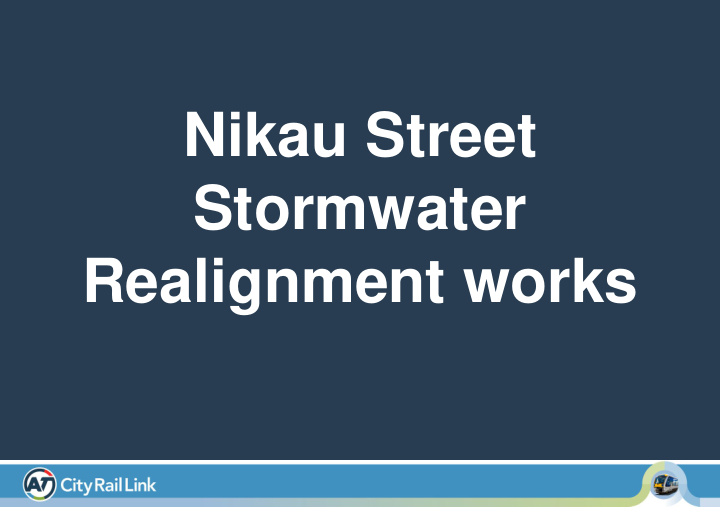



Nikau Street Stormwater Realignment works
Mt Eden Road shaft Nikau Street shaft Water Street shaft New pipe Old pipe Clash
Shaft Locations
Mount Eden Road Shaft 5
Water Street Shaft 6
Nikau Street Shaft 7
Management Plan / Detailed Works Plans Acronym Construction Environmental Management Plan CEMP Erosion and Sediment Control Plan ESCP Contamination DWP CDWP Air Quality DWP AQDWP Transport, Access and Parking DWP TAPDWP Construction Noise and Vibration Management CNVMP Plan Historic Character DWP HCDWP Communication and Consultation Plan CCP Trees and Vegetation DWP TVDWP
9 Nikau Street Stormwater Realignment REGIONAL CONSENT APPLICATION OUTLINE PLAN DISTRICT CONSENT APPLICATION CONSTRUCTION ENVIRONMENT MANAGEMENT PLAN SUB-PLANS Delivery Work Plans Management Plans Construction Noise Trees and Vegetation Communication and Site Specific Erosion and Vibration DWP DWP Consultation Plan and Sediment Control Plan Transport, Access and Contamination DWP Parking DWP Historic Character Air Quality DWP DWP
Construction Programme 10 Work Stages Apr-17 May-17 Jun-17 Jul-17 Aug-17 Sep-17 Oct-17 Nov-17 Dec-17 Jan-18 Feb-18 Mar-18 Apr-18 May-18 Mt Eden Road Shaft Nikau Street Shaft Water Street Shaft Pipe Jacking to Nikau Street Shaft Pipe Jacking to Water Street Shaft Site setup (including building demolition and utility diversion/protection) Piling (Not Nikau Street) Rockbreaking (Nikau Street Shaft only ) Shaft construction Pipe Jacking Permanent works and backfilling
Construction Noise and Vibration Craig Fitzgerald, Marshall Day Acoustics 15 November, 2016
Purpose of CNV DWP 12 • Objective - to identify the best practicable option (BPO) to avoid, remedy or mitigate adverse effects Plan outlines: • Project performance standards • Management and mitigation strategies • Process to address effects where compliance is not practicable
Conditions Construction Noise & Vibration 13 Project Standards (31, 33 & 34) Construction Noise and Vibration Delivery Work Plan (36) Site Specific Construction Noise and Vibration Management Plans (37 & 38)
Framework CNV DWP 14 The CNV DWP details: • Who is responsible for DWP implementation • Project noise and vibration standards • Predicted noise and vibration levels • Mitigation and management measures • Communication and complaints response • Monitoring and reporting methods • Review process
Mitigation and Management Measures 15 General measures include: • Sensitivity awareness – staff training • Restricted timing of some activities (e.g. piling and road cutting) • Prioritising low noise and vibration generating methods / equipment • Avoiding unnecessary noise and vibration (e.g. horns, squeaky tracks, engine revs) • Use of acoustic barriers and enclosures • Equipment maintenance
Exceedances - SSCNMP / SSCVMP 16 • Heavy civil works, narrow corridor, close y sensitive receivers = some predicted exceedances of the project standards • Reliance on CNV DWP to manage effects • SSCNVMPs to address effects of exceedances, prepared in consultation with affected parties
Predictions Noise 17 • Noise modelling has been undertaken for particularly busy or intense construction phases to inform the DWP. • Based on the model predictions, SSCNMPs are required for: - 24 Mt Eden Rd - 32 Nikau St - 36-38 Nikau St - 10 Ruru St - 27-29 Shaddock St - 33 Shaddock St - 11 Water St & 28 Mt Eden Rd - 12 Boston Road
Predictions Vibration 18 • Based on proposed equipment types and locations during construction, SSCVMPs are required for: - 31 Shaddock St
Air Quality DWP 19 Julia Lovelock, Golder and Associates 15 November, 2016
20 Air Quality Overview of Assessment Methodology and Assumptions • The dust assessment for the construction project considered the potential: – frequency and duration of impacts on sensitive locations; – intensity of dust impacts based: » on local wind data during strong wind events, and » separation distance to sensitive location. • The dust assessments were used to identify the degree of mitigation and monitoring required. • The assessments showed a high degree of mitigation is required given the sensitive environment.
21 Air Quality • Key Assessment Outcomes and Conclusions • Exposed unpaved areas are small and dust sources (such as from vehicle movements) are expected to be minimal. Excavated material expected to be damp. • However, activities sensitive to dust impacts will be close to the three construction sites and there is potential for adverse effects to occur. • Therefore, there is a need to control dust emissions to a high standard to avoid adverse dust effects in dry weather. Conclusion: Provided proposed dust control measures are implemented, it is expected that potential dust effects can be controlled and will be less than minor.
Air Quality 22 Dust Mitigation Includes • Dust suppression by spraying water during dry weather • Covering unpaved areas with coarse aggregate • Keeping vehicle speeds to 15 km/hr • Perimeter hoardings • Minimising size of stockpiles • Daily checks to confirm dust is being controlled Detailed framework for the dust management, mitigation and monitoring measures to be implemented within the Project’s Air Quality Management Plan.
Communication & Consultation Plan 23 Helen Hamilton, Carol Greensmith 15 November, 2016
24 Utilities investigation in Mt Eden Station area
Overview 25 • Investigation into condition of network utilities to assist with station design • Potholing, Ground Penetrating Radar (GPR) and drainage surveys including CCTV • Results will be used to plan utility diversions • 16 trenches proposed for Mt Eden Station area • Works may start as early as December 2016 • Duration of works will be 6 – 8 weeks • Works to take place during daytime hours
26 Questions or Comments?
Recommend
More recommend